The post-war era marked a significant turning point for Filipino creativity. After the devastation of World War II, the Philippines experienced a cultural revival that reshaped its artistic landscape. This period saw the emergence of new styles and themes, reflecting the nation’s resilience and evolving identity.
During this time, artists began to explore social realism, addressing the struggles and aspirations of everyday Filipinos. Figures like Vicente Manansala and Cesar Legaspi led this movement, blending traditional techniques with modern influences. Their work not only captured the spirit of the times but also laid the foundation for future generations.
Institutions like the Cultural Center of the Philippines and the National Museum played a crucial role in promoting and preserving these creative expressions. They provided platforms for artists to showcase their talent, ensuring that Filipino creativity continued to thrive. This era remains a testament to the enduring power of artistic expression in shaping cultural identity.
Key Takeaways
- The post-war era was a time of cultural revival in the Philippines.
- Social realism became a dominant theme in Filipino creativity.
- Artists like Vicente Manansala and Cesar Legaspi were key figures.
- Institutions supported and promoted artistic growth.
- This period laid the foundation for modern Filipino creativity.
Introduction to Filipino Art in the Post-War Era
The aftermath of World War II brought a wave of transformation to Filipino creative expression. As the country rebuilt itself, the cultural landscape began to shift, reflecting the resilience and adaptability of its people. This period marked a turning point where traditional forms blended with modern influences, creating a unique identity for Filipino creativity.
During this time, the practice of creativity expanded beyond traditional boundaries. Artists and creators started to explore new mediums and themes, addressing the social and political realities of the era. The term “creativity” began to encompass a wider range of expressions, from visual works to performance and literature.
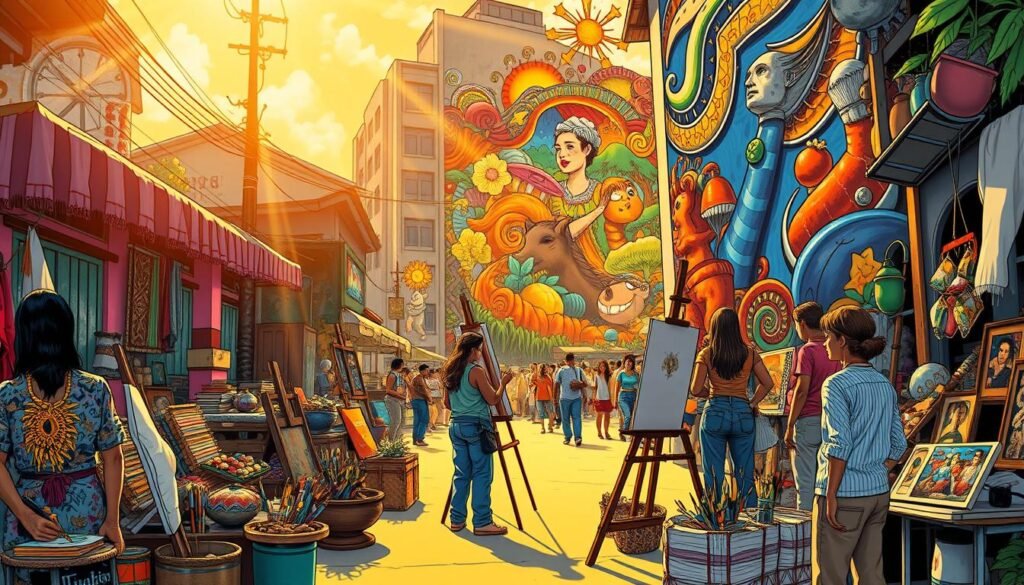
Historical events played a significant role in shaping these changes. The struggles of the war and the challenges of recovery influenced the themes and styles that emerged. Creativity became a tool for storytelling, capturing the hopes and struggles of everyday Filipinos.
Key influences during this period included global artistic movements and the desire to establish a distinct Filipino identity. These factors redefined creativity in the post-war context, setting the stage for the vibrant cultural scene that followed. The 20th century became a pivotal era for Filipino creativity, laying the foundation for future generations.
Historical Overview: From War to Cultural Revival
The years following World War II brought a profound transformation to Filipino culture. As the nation rebuilt, creativity became a powerful tool for healing and expression. This period marked a shift from survival to a celebration of identity and resilience.
Political and social factors played a significant role in shaping this cultural revival. The war’s devastation left deep scars, but it also inspired a desire to reclaim and redefine Filipino identity. Creativity emerged as a means to address the struggles and aspirations of everyday life.
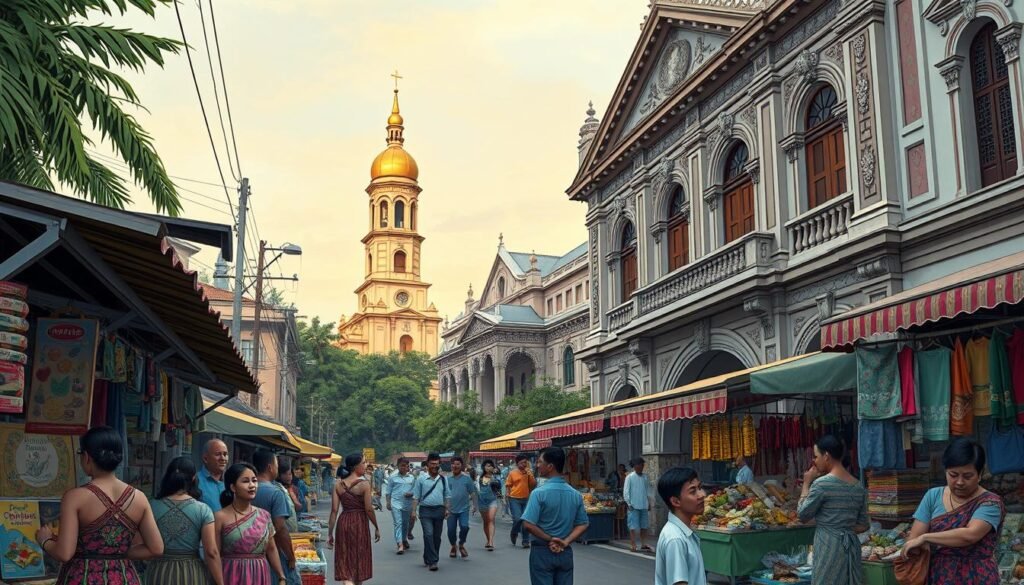
During this time, the definition art expanded beyond traditional forms. It became a medium for storytelling, capturing the hopes and challenges of a society in transition. Key figures like Vicente Manansala and Cesar Legaspi challenged conventional norms, blending traditional techniques with modern influences.
Significant movements emerged, reflecting the changing landscape of Filipino work art. Social realism gained prominence, focusing on the realities of post-war life. These works not only documented history but also inspired a sense of unity and purpose.
Below is a summary of key events and their impact on Filipino culture during this period:
| Year | Event | Impact |
|---|---|---|
| 1946 | Philippine Independence | Sparked a renewed focus on national identity |
| 1950s | Rise of Social Realism | Highlighted social issues and everyday struggles |
| 1960s | Establishment of Cultural Institutions | Provided platforms for artists and preserved cultural heritage |
This era laid the foundation for modern Filipino creativity, blending tradition with innovation. It remains a testament to the enduring power of cultural expression in shaping a nation’s identity.
Art in the Filipino Post-War Landscape
In the wake of World War II, Filipino creativity underwent a profound transformation. The devastation of war led to a reimagining of what creativity meant in the Filipino context. This period saw a new definition of creativity emerge, one that blended traditional methods with modern influences.
Aesthetics played a crucial role in this evolution. Artists began to focus on the visual representation of societal change, using their work to reflect the struggles and aspirations of everyday Filipinos. This shift was not just about beauty but about meaning and purpose.
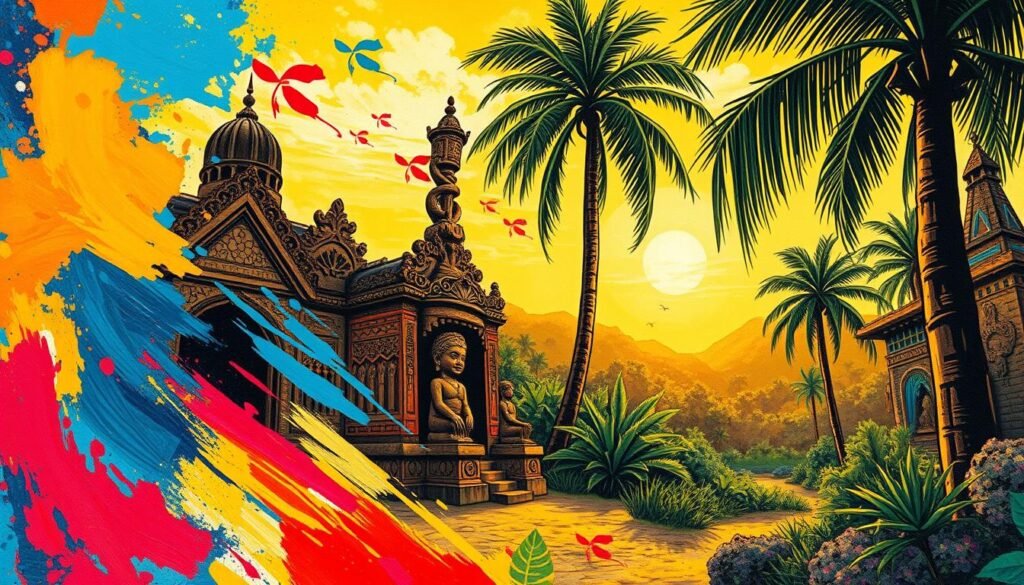
The artwork of this era became a powerful tool for storytelling. It captured the resilience of a nation rebuilding itself, blending traditional themes with modern techniques. This fusion created a unique identity for Filipino creativity, one that resonated both locally and globally.
Institutions like the Cultural Center of the Philippines played a pivotal role in this transformation. They provided platforms for artists to showcase their work, ensuring that creativity remained a vital part of national identity. These efforts helped redefine creativity as a cultural asset, essential for rebuilding and healing.
Below is a summary of key aspects of Filipino creativity in the post-war landscape:
| Aspect | Description |
|---|---|
| New Definition | Blended traditional and modern influences |
| Aesthetics | Focused on societal change and meaning |
| Artwork | Reflected resilience and national identity |
| Institutional Role | Provided platforms for creative expression |
This era marked a turning point for Filipino creativity, setting the stage for future generations to explore and innovate. It remains a testament to the enduring power of creativity in shaping cultural identity.
Defining Art and Aesthetics in the Filipino Context
The Filipino understanding of creativity has evolved uniquely over time. Rooted in a rich cultural history, it reflects a blend of traditional and modern influences. This evolution has shaped the way creativity is defined and appreciated in the Philippines.
Traditional forms of creativity, such as weaving and indigenous crafts, have long been part of Filipino culture. These practices emphasize community and heritage. In contrast, modern expressions often incorporate global trends, creating a dynamic fusion.
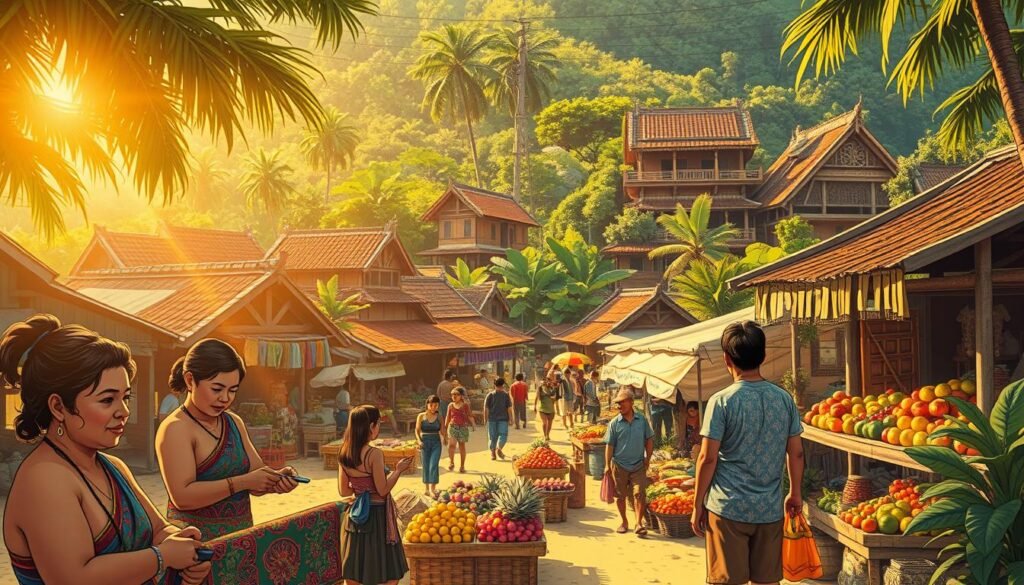
Cultural institutions have played a crucial role in this evolution. The University of the Philippines School of Fine Arts, for example, has been a hub for nurturing talent and preserving traditional techniques. These institutions provide a platform for artists to explore and innovate.
The history of Filipino creativity is deeply intertwined with its social and political landscape. From the post-war era to the present, creativity has been a tool for expressing identity and resilience. This connection highlights the importance of understanding creativity within its cultural context.
Below is a summary of key aspects of Filipino creativity and aesthetics:
| Aspect | Description |
|---|---|
| Traditional Forms | Rooted in indigenous practices and community heritage |
| Modern Expressions | Blend global trends with local influences |
| Role of Institutions | Provide platforms for preservation and innovation |
| Historical Context | Reflects social and political evolution |
This balance between tradition and modernity defines Filipino creativity. It showcases the nation’s ability to adapt while staying true to its roots. Understanding this duality is key to appreciating the depth of Filipino aesthetics.
Glossary of Art Terms and Concepts
Understanding key terms is essential to exploring Filipino creativity. This section serves as a glossary, clarifying the terminology that shapes the nation’s artistic expression. By defining these concepts, readers gain a deeper appreciation of the culture and history behind Filipino works.
An art form refers to the specific medium or style used to create a work. In the Philippines, traditional forms like weaving coexist with modern techniques such as digital design. This blend reflects the dynamic nature of Filipino culture.
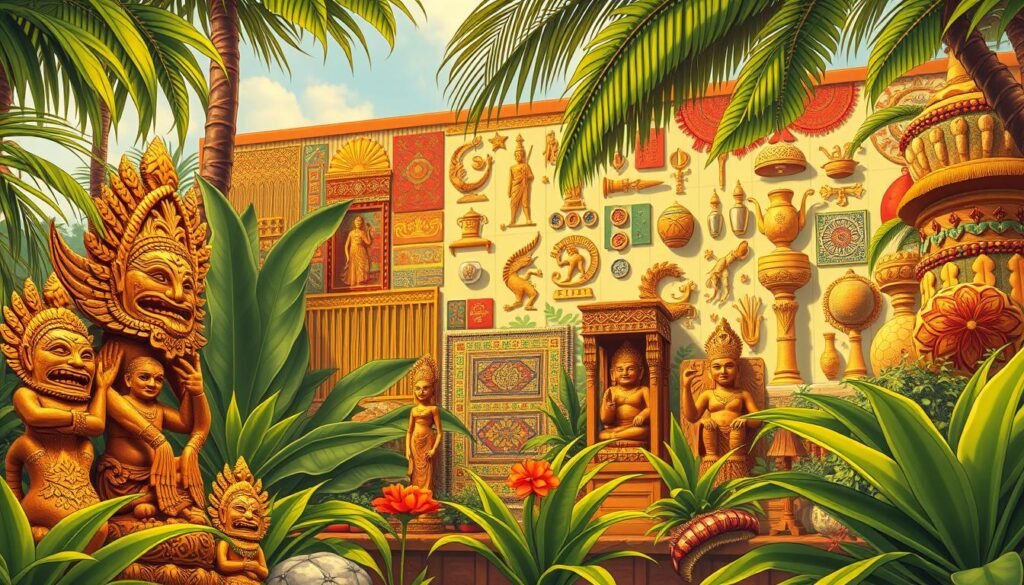
One fact about Filipino creativity is its adaptability. From indigenous crafts to contemporary installations, the art form evolves while staying rooted in tradition. This duality is a hallmark of the nation’s creative identity.
Another key term is culture, which encompasses the shared values and practices of a community. In the Filipino context, creativity often reflects societal themes, making it a powerful tool for storytelling and expression.
Historical movements like Abstract Expressionism and Cubism have influenced Filipino art forms. These global trends merged with local traditions, creating a unique blend that defines the nation’s creative landscape.
Color Field Painting, for example, emphasizes large areas of color to evoke emotion. This technique has been adapted by Filipino artists to reflect their culture and experiences. Such adaptations highlight the versatility of Filipino creativity.
Understanding these terms provides a foundation for exploring specific movements and ideas. It ensures readers have a common reference point when discussing Filipino art forms and their significance.
Institutions like the Cultural Center of the Philippines play a vital role in preserving these facts and traditions. They provide platforms for artists to showcase their work, ensuring that Filipino creativity continues to thrive.
This glossary is not just a list of definitions. It’s a gateway to understanding the rich culture and history that shape Filipino creativity. By decoding these terms, readers can better appreciate the depth and diversity of the nation’s artistic expression.
Influential Filipino Artists and Their Legacies
The post-war period in the Philippines gave rise to a generation of artists whose work continues to inspire. These creators not only showcased exceptional skill but also used their work to objectify cultural and personal narratives. Their contributions have left a lasting impact on contemporary practices.
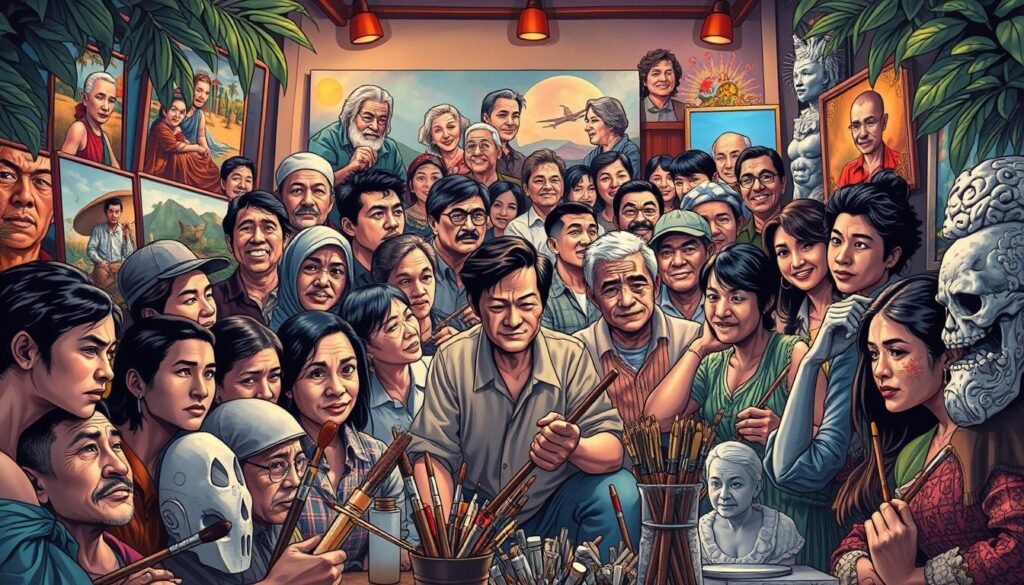
One notable example is Fernando Amorsolo, often referred to as “The Painter of Light.” His naturalistic style and rural themes resonated deeply with the Filipino populace. Works like “The Resplendent Quetzal” and “Mayon Volcano in Eruption” highlight his mastery of light and shadow, capturing both beauty and historical significance.
Another influential figure is Apo Whang-Od, the world’s oldest traditional tattoo artist. Her skill in the hand-tap method, using bamboo sticks and thorns, has preserved the Kalinga tattooing tradition. Her work, deeply rooted in indigenous beliefs, has inspired a global revival of traditional tattooing practices.
- Fernando Amorsolo’s paintings are celebrated for their naturalistic style and rural themes.
- Apo Whang-Od’s tattooing technique emphasizes precision and cultural preservation.
- Both artists’ works objectify the resilience and identity of Filipino culture.
The legacies of these artists extend beyond their lifetimes. Amorsolo’s influence is evident in the continued appreciation for his paintings, while Whang-Od’s work has sparked a renewed interest in traditional tattooing. Their contributions serve as a testament to the enduring power of creativity in shaping cultural identity.
These artists’ ability to blend tradition with innovation highlights their exceptional skill. Their work not only reflects the past but also inspires future generations to explore and innovate. Their stories remind us of the profound impact that creativity can have on society.
Key Movements Shaping Post-War Filipino Creativity
The post-war period in the Philippines sparked a creative revolution that redefined the nation’s cultural identity. This era saw the emergence of movements that blended traditional techniques with modern influences, creating a unique artistic landscape. Painting, in particular, became a powerful medium for expressing the struggles and aspirations of the Filipino people.
One of the most significant movements was social realism. Artists like Vicente Manansala and Cesar Legaspi used their work to highlight the purpose of creativity in addressing societal issues. Their paintings captured the resilience of a nation rebuilding itself, blending bold colors and abstract forms to convey powerful messages.
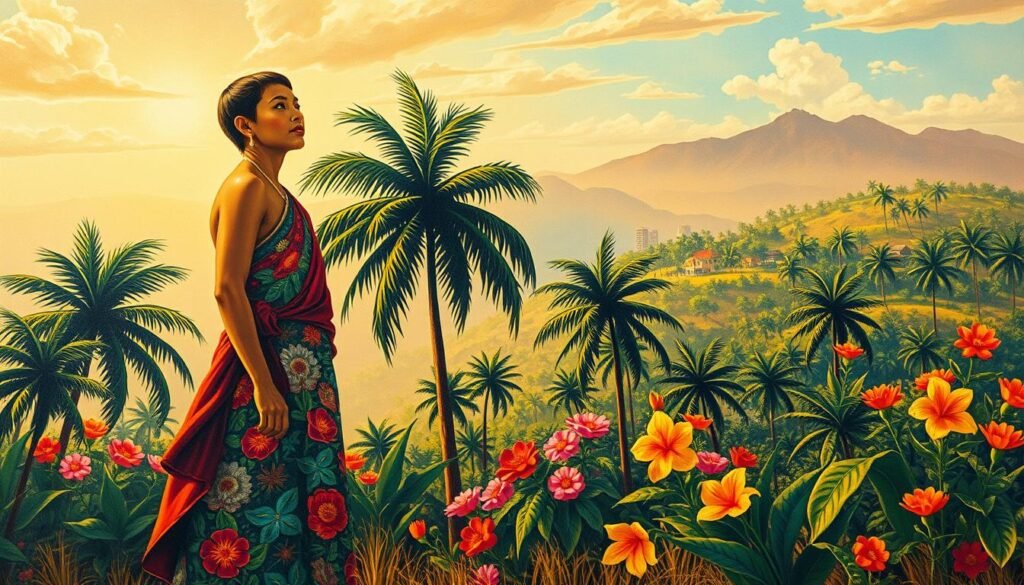
Another key movement was the rise of abstract expressionism. This style allowed artists to explore something beyond the literal, using shapes and colors to evoke emotion and thought. It reflected the uncertainty and hope of the post-war era, offering a new way to interpret the world.
Performance art also gained traction during this time. Artists used their bodies and voices to challenge norms and provoke thought. This form of expression became a platform for addressing political and social issues, further expanding the purpose of creativity in the Philippines.
Below are some key movements and their impact:
- Social Realism: Focused on everyday struggles and societal issues.
- Abstract Expressionism: Explored emotions and abstract concepts.
- Performance Art: Used the body as a medium for political and social commentary.
These movements not only redefined traditional forms but also inspired future generations of artists. They showcased the power of creativity to capture the essence of a nation in transition, leaving a lasting legacy in Filipino culture.
The Influence of Western and Global Art Theories
The exchange of global ideas reshaped Filipino creativity after the war. Western theories and international styles began to influence local practices, creating a dynamic blend of tradition and innovation. This period marked a significant shift in how Filipino creators approached their work.
Cultural institutions played a crucial role in this transformation. Museums and galleries became platforms for introducing new perspectives. They showcased international exhibitions, allowing Filipino artists to engage with global trends. This exchange enriched the local creative landscape.
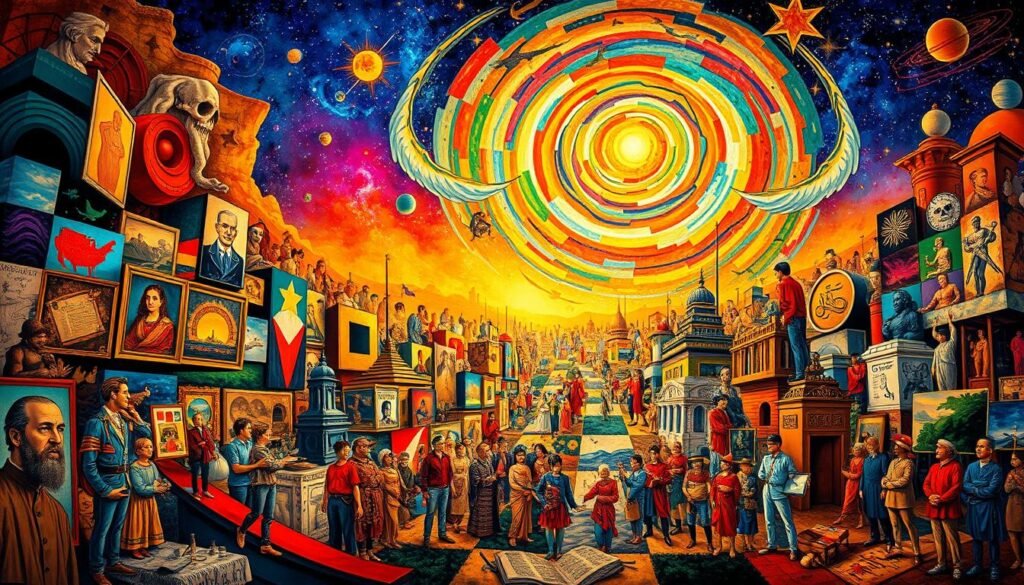
One notable example is the integration of abstract expressionism into Filipino works. Artists like Vicente Manansala adopted this style, blending it with traditional themes. This fusion created a unique identity that resonated both locally and globally.
The world of creativity expanded during this time, with artists exploring new mediums and techniques. The Cultural Center of the Philippines, for instance, hosted debates and workshops that encouraged experimentation. These efforts helped bridge the gap between traditional and contemporary practices.
Below are key ways global influences shaped Filipino creativity:
- Introduction of abstract and modernist styles.
- Increased collaboration with international artists.
- Expansion of creative education through museums and institutions.
This era highlights the power of cultural exchange in shaping creativity. It shows how Filipino artists embraced global ideas while staying true to their roots. The result was a vibrant and evolving creative landscape that continues to inspire today.
Traditional Versus Contemporary Artistic Practices
The evolution of Filipino creativity reveals a fascinating interplay between tradition and modernity. This section delves into how historical techniques and new innovations coexist, shaping the creative landscape of the Philippines.
Traditional practices, rooted in centuries-old methods, emphasize meticulous craftsmanship and cultural preservation. These techniques, passed down through generations, reflect the experience and identity of the Filipino person. In contrast, contemporary methods embrace experimentation, often incorporating modern technology and unconventional materials.
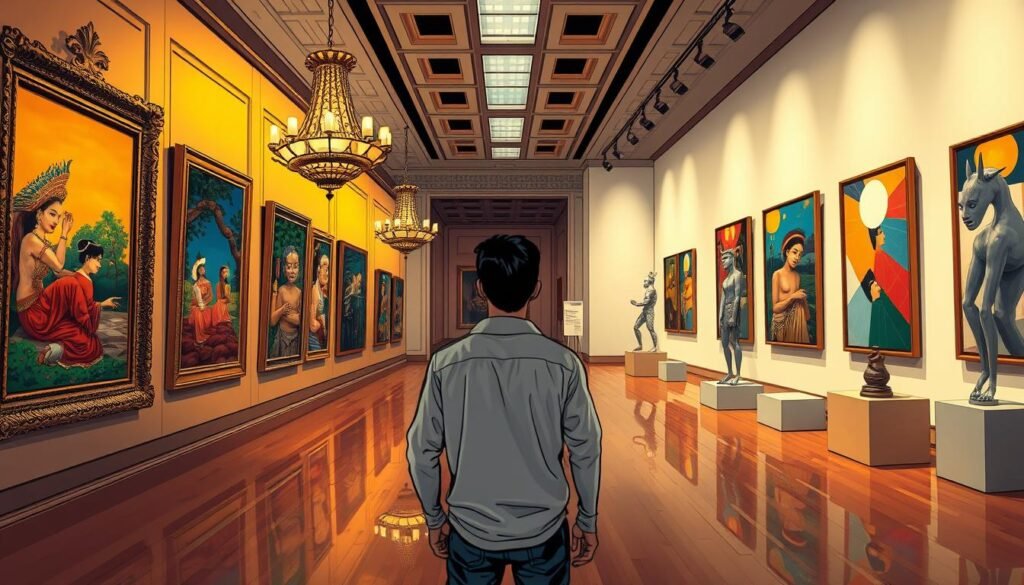
One striking example is the blending of indigenous weaving with digital design. Traditional weavers collaborate with modern creators to produce works that honor heritage while appealing to today’s audiences. This fusion highlights the adaptability of Filipino creativity.
Cultural shifts have also played a role in this transformation. As society evolves, so does the experience of creating. Contemporary artists often address pressing issues like environmental sustainability and social justice, reflecting the new realities of the modern world.
Below are key differences between traditional and contemporary practices:
- Traditional: Focuses on cultural preservation and meticulous detail.
- Contemporary: Embraces innovation and addresses modern themes.
- Both: Contribute to the rich tapestry of Filipino creativity.
For a deeper understanding of these practices, explore this comparative analysis of traditional and contemporary artistic.
This blend of old and new ensures that Filipino creativity remains vibrant and relevant. It showcases the resilience and adaptability of the Filipino person, offering a unique perspective on the global stage.
The Role of Visual Media and Performance in Art
Visual media and performance have become essential tools in redefining creative boundaries in the Philippines. These forms of expression allow creators to explore new dimensions, blending traditional techniques with modern innovations. This integration reflects the dynamic nature of Filipino society, where creativity evolves to address contemporary issues.
From digital installations to live performances, creators are pushing the limits of what is possible. This evolution highlights the importance of adaptability in the creative process. It also underscores how visual media and performance can convey complex ideas in ways that resonate deeply with audiences.
Exploring Diverse Creative Mediums
In today’s creative landscape, technology plays a pivotal role. Digital tools have opened up new possibilities, allowing creators to experiment with sorts of mediums. From 3D modeling to interactive installations, these innovations are reshaping how we experience creativity.
Traditional methods, such as painting and sculpture, continue to thrive alongside these modern techniques. This coexistence creates a rich tapestry of expression, where the past and present merge seamlessly. It also reflects the diverse society that inspires these works.
Below is a comparison of traditional and modern creative mediums:
| Medium | Characteristics |
|---|---|
| Traditional | Handcrafted, rooted in cultural heritage |
| Modern | Digital, interactive, and experimental |
Crossover Between Performance and Visual Expression
Performance and visual expression often intersect, creating powerful narratives. This crossover allows creators to engage audiences on multiple levels, appealing to both the eyes and the senses. It also provides a platform for addressing societal issues in innovative ways.
For example, performance art can incorporate visual elements like projections or installations. This blend enhances the storytelling process, making it more immersive and impactful. It also challenges traditional notions of what creativity can be.
Key aspects of this crossover include:
- Integration of visual and performative elements.
- Use of technology to enhance audience engagement.
- Focus on conveying complex ideas through multi-sensory experiences.
This fusion of mediums highlights the evolving nature of creativity in the Philippines. It showcases how creators are redefining boundaries to reflect the changing society and its diverse senses of identity.
Intersection of Politics, Society, and Artistic Expression
The interplay between politics and creativity has long shaped Filipino cultural expression. From the post-war era to the present, socio-political forces have consistently influenced the themes and methods of artistic practices. This section examines how these forces have redefined the content and direction of Filipino creativity.
Historical events often serve as a mirror for artistic expression. For instance, the post-war period saw artists like Vicente Manansala and Cesar Legaspi addressing societal struggles through their work. Their paintings captured the resilience of a nation rebuilding itself, blending traditional techniques with modern influences. This fusion created a unique identity that resonated both locally and globally.
Figures like Marcel Duchamp also played a role in challenging traditional norms. Duchamp’s approach to redefining content in art inspired Filipino creators to experiment with new forms and ideas. His influence is evident in the way contemporary artists use their work to address political and social issues.
The role of art history is crucial in understanding these transformations. By studying past movements, we gain insights into how creativity evolves in response to societal changes. For example, the rise of social realism in the Philippines was a direct response to the struggles of the post-war era. This movement highlighted the importance of using art as a tool for storytelling and social commentary.
“Art is not just about beauty; it’s about meaning and purpose. It reflects the world we live in and challenges us to think differently.”
Below is a summary of key ways politics and society have influenced Filipino creativity:
| Aspect | Influence |
|---|---|
| Historical Events | Shaped themes and methods of artistic expression |
| Global Influences | Inspired experimentation with new forms and ideas |
| Social Realism | Highlighted societal struggles and resilience |
| Art History | Provided insights into the evolution of creativity |
For a deeper understanding of how politics and art intersect, explore this detailed analysis.
This intersection of politics, society, and creativity continues to shape the Filipino cultural landscape. It showcases the power of artistic expression to reflect and influence the world around us.
Economic and Institutional Impact of Art in the Philippines
Economic forces and institutional support have played a pivotal role in shaping the Filipino creative landscape. From government policies to private funding, these elements have driven the growth of artistic expression and innovation. The interplay between financial resources and cultural institutions has created a dynamic environment for creators to thrive.
Global hubs like New York and London have set benchmarks for art markets, inspiring local developments in the Philippines. These cities showcase how economic power can elevate artistic expression and provide platforms for emerging talents. Filipino artists, particularly woman creators, have benefited from these global influences, gaining recognition both locally and internationally.
Cultural institutions like the Cultural Center of the Philippines have been instrumental in fostering creativity. They provide funding, exhibitions, and educational programs that support artists at every stage of their careers. This institutional backing ensures that Filipino expression remains vibrant and relevant.
Government policies have also played a crucial role. Initiatives to promote cultural heritage and creative industries have opened doors for artists to explore new mediums and themes. These efforts highlight the symbiotic relationship between institutions and creative innovation, ensuring that the Philippines remains a hub for artistic expression.
“Art is not just a reflection of culture; it’s a driver of economic growth and social change.”
Below are key ways economic and institutional factors have shaped Filipino creativity:
- Global Influence: Cities like New York inspire local developments.
- Institutional Support: Cultural centers provide platforms for artists.
- Government Policies: Initiatives promote cultural heritage and innovation.
- Empowering Women: Woman artists gain recognition and opportunities.
This combination of economic power and institutional support ensures that Filipino creativity continues to evolve, reflecting the nation’s resilience and adaptability.
The Evolution of Artistic Techniques and Mediums
The evolution of artistic techniques has reshaped how creators approach their work. From traditional methods to modern innovations, the medium of expression has expanded, offering new possibilities for creativity. This section explores how these advancements have redefined the creative process.
Innovative Painting and Sculpture Methods
Traditional techniques like encaustic and fresco have laid the foundation for modern practices. Encaustic, using hot beeswax, and fresco, with water-based pigments, showcase the ingenuity of early creators. These methods have evolved, blending with contemporary styles to create unique images.
Oil painting, dominant since the 16th century, remains a favorite for its rich colors and fine detail. Techniques like sfumato and impasto add depth and texture, transforming the medium into a powerful tool for storytelling. Sculpture, too, has seen innovations, with materials and methods adapting to modern themes.
The Rise of Digital and Mixed-Media Art
The advent of digital tools has revolutionized creativity. Artists now use software and technology to craft intricate images, pushing the boundaries of traditional mediums. Mixed-media art, combining physical and digital elements, has sparked controversy over what qualifies as true creativity.
Despite the controversy, these innovations have opened doors for creators to experiment and innovate. Digital art allows for global sharing, while mixed-media works challenge established norms. These advancements continue to expand the definition of artistic expression.
| Technique | Description |
|---|---|
| Encaustic | Uses hot beeswax for binding pigments |
| Fresco | Water-based pigments penetrate plaster |
| Oil Painting | Rich colors and fine detail |
| Digital Art | Software-driven creativity |
| Mixed-Media | Combines physical and digital elements |
These innovations highlight the dynamic nature of creativity. They show how mediums and techniques evolve, reflecting the changing world and inspiring future generations.
Preserving the History and Legacy of Filipino Art
The preservation of Filipino creativity has become a cornerstone of cultural identity in the modern era. As the world evolves, safeguarding the rich heritage of Filipino works ensures that future generations can connect with their roots. This section explores the variety of efforts made to protect and celebrate this legacy.
Museums, Archives, and Cultural Institutions
Museums and cultural institutions play a vital role in preserving Filipino creativity. These organizations follow strict principles of conservation to protect historical works from deterioration. The National Museum of the Philippines, for example, houses an extensive collection of traditional and contemporary pieces, ensuring their accessibility to the public.
Institutions like the Cultural Center of the Philippines also provide platforms for exhibitions and educational programs. These efforts not only preserve creativity but also inspire new generations to explore their cultural heritage. Comparing these initiatives to those in London, such as the British Museum, highlights the global importance of cultural preservation.
Community Initiatives and Educational Programs
Beyond formal institutions, community-led initiatives are essential in promoting creativity. Local organizations often organize workshops and festivals to celebrate traditional techniques. These programs foster a sense of pride and continuity within communities.
Educational programs also play a crucial role. Schools and universities integrate Filipino creativity into their curricula, ensuring that students understand its significance. For instance, the University of the Philippines offers courses that explore the variety of traditional and modern techniques, bridging the gap between past and present.
Below is a summary of key institutions and their roles in preserving Filipino creativity:
| Institution | Role |
|---|---|
| National Museum of the Philippines | Preserves historical and contemporary works |
| Cultural Center of the Philippines | Hosts exhibitions and educational programs |
| University of the Philippines | Integrates creativity into academic curricula |
These efforts highlight the principle of collective responsibility in safeguarding cultural heritage. By working together, institutions and communities ensure that Filipino creativity remains vibrant and relevant.
For more insights into preserving Filipino creativity through digital technology, explore this detailed analysis.
Analyzing Glossary Definitions: Perspectives and Debates in Art Criticism
The definition of creativity has sparked intense debates among scholars and critics. These discussions often revolve around the means used to classify and interpret creative works. Some argue that creativity is best understood through its institutional context, while others emphasize its aesthetic value.
One key debate centers on the role of media in shaping definitions. Traditional forms like painting and sculpture are often contrasted with modern media such as digital installations. This shift has expanded the boundaries of what is considered creative, challenging established norms.
Another critical aspect is the inclusion of performance in these definitions. From theater to live art, performance has become a powerful means of expression. Critics argue that it adds a dynamic, interactive element to creativity, enriching its interpretation.
“Creativity is not confined to a single medium; it thrives in the interplay of forms and ideas.”
Historically, institutional criteria have dominated the discourse. Museums and galleries often dictate what is deemed valuable. However, contemporary critics advocate for a broader perspective, one that includes grassroots and community-driven media.
Below are key perspectives in this ongoing debate:
- Institutional Context: Focuses on the role of cultural institutions in defining creativity.
- Aesthetic Value: Emphasizes the visual and emotional impact of creative works.
- Media and Performance: Highlights the evolving role of technology and live expression.
For a deeper understanding of these debates, explore this detailed analysis of art criticism.
These discussions underscore the complexity of defining creativity. By examining diverse means and perspectives, we gain a richer understanding of its role in society. Whether through traditional media or innovative performance, creativity continues to evolve, reflecting the ever-changing world around us.
Conclusion
The post-war era in the Philippines reshaped the nation’s cultural identity through creative expression. From sculpture to broader practices, Filipino creativity has played a pivotal role in reflecting societal changes and resilience.
Historical, economic, and institutional factors have deeply influenced this evolution. The rise of social realism and the blending of traditional and modern techniques highlight the enduring subject matters that define Filipino expression.
As we look to the future, the legacy of post-war creativity continues to inspire new generations. Exploring its rich history offers valuable insights into the cultural fabric of the Philippines.
FAQ
What defines Filipino art in the post-war era?
Filipino art in the post-war era is characterized by a blend of traditional practices and modern influences, reflecting the nation’s recovery and cultural revival. Artists explored themes of identity, resilience, and social change.
Who were some influential Filipino artists during this period?
Prominent figures include Fernando Amorsolo, known for his idyllic rural scenes, and Vicente Manansala, who pioneered the Cubist-inspired “Transparent Cubism” style. Their works shaped the trajectory of Filipino creativity.
How did global art theories influence Filipino artists?
Western and global art theories introduced new techniques and perspectives, encouraging Filipino creators to experiment with abstraction, surrealism, and other avant-garde movements while retaining local themes.
What role did politics play in post-war Filipino art?
Politics deeply influenced artistic expression, with many works addressing issues like colonialism, social inequality, and national identity. Art became a powerful medium for commentary and activism.
How did traditional and contemporary practices coexist?
Traditional practices, such as folk art and indigenous crafts, merged with contemporary methods like digital media and performance art, creating a dynamic and diverse artistic landscape.
What institutions helped preserve Filipino art history?
Museums like the National Museum of the Philippines and cultural institutions such as the Cultural Center of the Philippines played key roles in archiving and promoting the nation’s artistic heritage.
How did economic factors impact the art scene?
Economic challenges limited resources for many artists, but it also spurred innovation and community-driven initiatives, fostering resilience and collaboration within the creative sector.
What mediums gained popularity in post-war Filipino art?
Painting and sculpture remained dominant, but artists increasingly embraced mixed media, digital art, and performance, reflecting the evolving nature of artistic expression.
How did Filipino artists address societal issues?
Through their works, artists tackled themes like poverty, human rights, and environmental concerns, using their platforms to spark dialogue and inspire change.
What is the significance of community programs in art preservation?
Community programs and educational initiatives help ensure that Filipino art traditions are passed down to future generations, fostering a sense of cultural pride and continuity.
Source Links
- The Evolution of Filipino Art: A Journey Through Time
- Inspired by Filipino art and design
- The Development of Art Galleries in the Philippines – National Commission for Culture and the Arts
- The Philippine Literature and Arts in the Post-War Era (1946-1972)
- Arts in the Philippines
- Philippine Contemporary Art as a Post-War Phenomenon – National Commission for Culture and the Arts
- Art history | Painting, Sculpture & Architecture | Britannica
- Renaissance Art ‑ Characteristics, Definition & Style
- History of art
- Social Realism: The Turns of a Term in the Philippines | Afterall
- Contemporary Arts in the Philippines: An Introduction
- The Evolution of Filipino Art: A Journey Through Time
- In Focus: The Art of Juan Luna – National Commission for Culture and the Arts
- Context of Art
- Art Terminology – a glossary — ModernArts
- Glossary of Art Terms – IMMA
- Art Terms | Tate
- Fernando Amorsolo – Early Philippine Art – We Buy & Sell Filipino Paintings
- The Legacy and Artistry of Apo Whang-Od, the 106-Year-Old Tattoo Artist Featured in Vogue — Certified Tattoo Studios
- The State of Creative Activism in Post-Cold War Southeast Asia and the 2021 Myanmar Crisis – Kyoto Review of Southeast Asia
- WESTERN INFLUENCES ON PHILIPPINE ART
- 1.2: Interconnections of History and Art
- Art
- Contemporary vs Traditional Art: The Differences that You Must Know
- Traditional Art vs. Modern Art: Understanding the Differences
- Power of Visual Perception: Shaping the Visual Arts | LU
- Visual Art Performance vs. Contemporary Performance
- How Art and Politics Influence and Shape Each Other
- The Intersection of Art and Politics: The Power of Art to Inspire Change and Challenge the Status Quo
- The arts and politics
- CCP Encyclopedia of Philippine Art | CCP Encylopedia of Philippine Art
- Microsoft Word – Chapter 6-Philippines Report–as of June 13
- Various Painting and Drawing Mediums and Techniques – ARTDEX
- The Evolution of Art Throughout History
- The cultural significance of traditional Filipino art techniques – ARTventure Magazine
- Microsoft Word – ACERP2018_39527.doc
- Cultural Bayanihan: Celebrating and Preserving Filipino Heritage
- Art Criticism And Analysis: Art Definitions & Examples
- Art criticism
- Art Criticism: Understanding and Evaluating Contemporary Art
- Conclusion – Pop Art and the Origins of Post-Modernism

